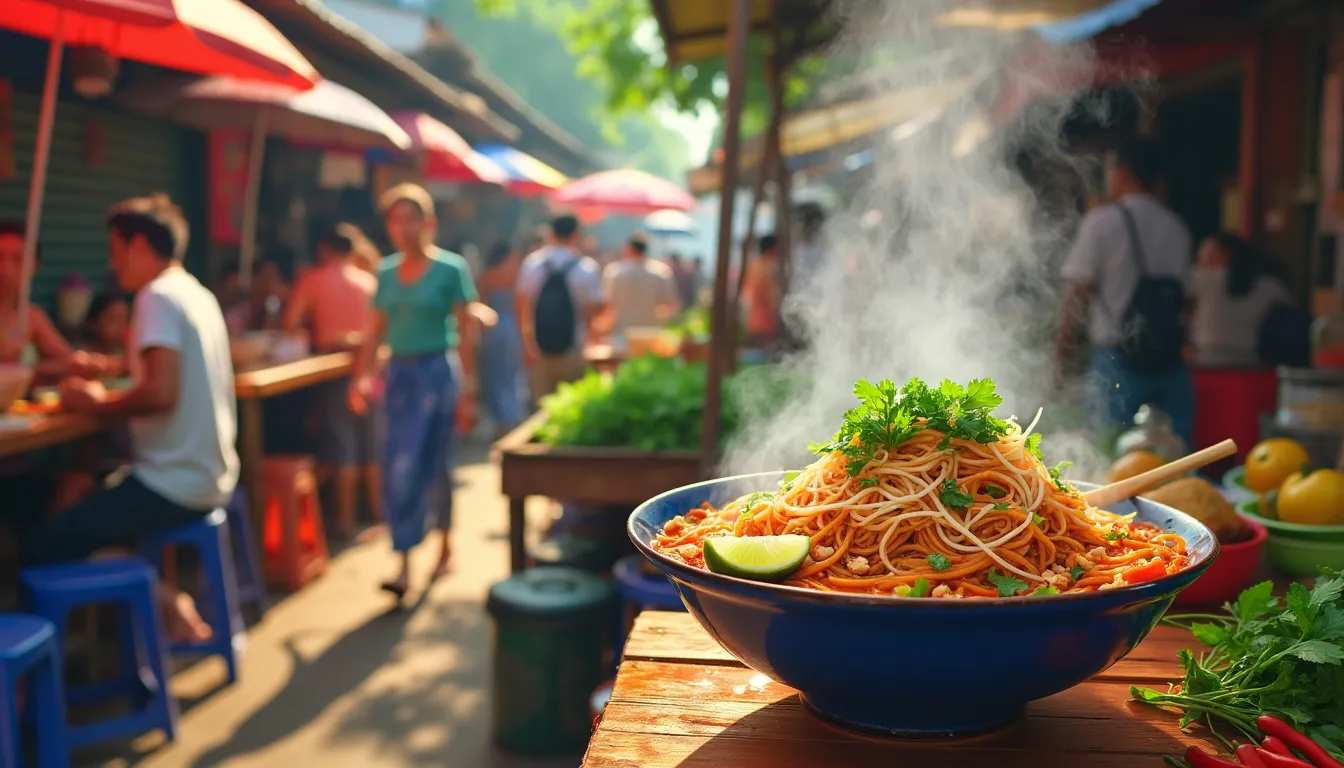Embark on a culinary journey with Thai street noodles, a vibrant and delectable staple of Thailand’s bustling street food scene. Immerse yourself in the rich history and diverse varieties of these flavorful noodles, each bowl telling a unique story of tradition, culture, and innovation. From the ever-popular Pad Thai with its perfect balance of sweet, sour, salty, and spicy, to the robust and aromatic Boat Noodles, to the savory and satisfying Pad See Ew, Thai street noodles offer a tantalizing array of options that cater to every palate.
Understanding the appeal of Thai street noodles begins with their essential ingredients. The interplay of fresh herbs, bold spices, and high-quality proteins creates a symphony of flavors that are both complex and harmonious. Dive deep into the flavor profiles and cooking techniques that make Thai street noodles a beloved comfort food for locals and a must-try for travelers. Whether you’re strolling through a bustling Bangkok night market or recreating these dishes at home, the world of Thai street noodles promises an unforgettable gastronomic experience.
Thai street noodles are not just a popular staple in Thailand, but they have garnered international acclaim for their incredible flavors and textures. To truly appreciate the beauty of Thai street noodles, one must delve into their rich history and understand the diverse varieties available. This section aims to uncover the origins, evolution, and popular types of Thai street noodles that enchant palates worldwide.
A Brief History of Thai Street Noodles
The history of Thai street noodles is a tale of cultural amalgamation, innovation, and tradition. Noodles were introduced to Thailand by Chinese immigrants centuries ago. Over time, Thai people began to incorporate their distinctive flavors and ingredients into these noodle dishes, giving rise to what we now know as Thai street noodles.
In the mid-20th century, to combat the ongoing economic crisis and increase rice consumption, the Thai government promoted noodles as an alternative staple. This led to the widespread popularity of various noodle dishes, especially on the streets where vendors expertly crafted these meals to cater to the bustling urban population. Today, Thai street noodles are a testament to the country’s culinary ingenuity and rich heritage.
Popular Types of Thai Street Noodles
Pad Thai
Perhaps the most internationally renowned Thai street noodle dish is Pad Thai. This iconic dish is a harmonious blend of sweet, sour, salty, and spicy flavors. Pad Thai generally comprises stir-fried rice noodles with eggs, tofu, shrimp or chicken, bean sprouts, peanuts, and a generous squeeze of lime. The sauce, often made from tamarind paste, fish sauce, garlic, and chili peppers, gives it that irresistible taste.
Pad Thai’s appeal lies in its perfect balance of flavors and textures. Each bite offers a delightful combination of chewiness from the noodles, crunch from the bean sprouts and peanuts, and a burst of tanginess from the lime. This dish truly encapsulates the essence of Thai cuisine, making it a must-try for anyone exploring Thai street noodles.
Boat Noodles (Kuay Teow Reua)
Boat noodles, or Kuay Teow Reua, have a fascinating origin story. Traditionally sold from boats that navigated Bangkok’s canals, these noodles are now popularly enjoyed throughout the city and beyond. The dish is typically a hearty, flavorful beef or pork noodle soup with a rich, spiced broth.
What sets boat noodles apart is the depth of flavor, often achieved by incorporating cow or pig blood into the broth, mingling with herbs and spices like star anise, cinnamon, garlic, and coriander. The noodles, usually rice noodles, are served with small pieces of meat, liver, meatballs, and a sprinkling of fresh herbs. This dish, while a bit more adventurous, offers a bold and satisfying experience for noodle enthusiasts.
Pad See Ew
For those who prefer a milder yet equally flavorful option, Pad See Ew is a favorite. This dish features wide, flat rice noodles stir-fried with soy sauce, Chinese broccoli or kale, and a choice of meat or tofu. The dark soy sauce lends a slightly sweet and savory taste to the noodles, while the Chinese broccoli adds a pleasant crunch.
The key to an authentic Pad See Ew lies in the use of wok hei, or the breath of the wok. This technique involves stir-frying the ingredients at high heat to achieve a smoky flavor and slight charring on the noodles. Pad See Ew is a comforting, straightforward dish, perfect for both novices and connoisseurs of Thai street noodles.
Each variety of Thai street noodles offers a unique journey through Thailand’s culinary landscape. Whether savoring the balanced complexity of Pad Thai, diving into the robust flavors of Boat Noodles, or enjoying the comforting simplicity of Pad See Ew, there is a noodle dish to captivate every palate.
As we continue to explore the world of Thai street noodles, understanding their history and diversity is crucial. These dishes not only highlight the importance of noodles in Thai cuisine but also reflect the cultural richness and culinary creativity of Thailand. By appreciating the origins and variations of Thai street noodles, we can better savor each delectable bite.

Experiencing the Unique Ingredients and Flavors of Thai Street Noodles
Essential Ingredients in Thai Street Noodles
When it comes to Thai street noodles, the ingredients are as vibrant and diverse as its rich history. Essential components include rice noodles, which come in various thicknesses like the thin rice noodles used in Pad Thai or the broader noodles found in Pad See Ew. Shrimp, chicken, and pork serve as common protein choices, adding heartiness to the dish.
Adding a burst of flavor, fish sauce is indispensable in Thai street noodles, providing a savory umami kick. Meanwhile, tamarind pulp brings a tangy sweetness, particularly prominent in Pad Thai. Vegetables such as bean sprouts, scallions, and Chinese broccoli offer a fresh crunch that contrasts beautifully with the soft textures of the noodles and proteins.
Don’t forget peanuts and lime wedges that provide the final touch, adding both texture and a zesty finish. Chili flakes and garlic are also often featured, contributing to the balance of spicy and savory flavors characteristic of Thai street noodles. These ingredients work in harmony to create a symphony of flavors that are both satisfying and unique.
Flavor Profiles and Cooking Techniques Used in Thai Street Noodles
Thai street noodles are renowned for their complex and bold flavors, achieved through meticulous cooking techniques. One of the foundational flavor profiles is a balance of sweet, salty, sour, and spicy. This balance is what makes Thai street noodles so incredibly delicious and universally adored.
Take Pad Thai for instance. This iconic noodle dish harmonizes sweetness from palm sugar, saltiness from fish sauce, and tanginess from tamarind, all rounded out with a subtle hint of heat from chili flakes. The noodles are stir-fried until they are caramelized, giving the dish its distinctive smoky depth. Cooking on a high heat in a well-seasoned wok ensures that the sauce coats each noodle perfectly, infusing every bite with flavor.
Another classic, Boat Noodles, have an entirely different but equally intricate flavor profile. Beef or pork blood is combined with various spices, star anise, and cinnamon, resulting in a rich and hearty broth that’s uniquely fragrant. Additional ingredients like Thai basil and bean sprouts provide fresh herbal notes, while lime juice adds a zesty brightness.
Pad See Ew focuses on the interplay between savory and sweet. This dish features broad rice noodles stir-fried with soy sauce, sugar, and garlic. The noodles are typically cooked until they develop a delightful smoky char, known as wok hei, which translates to breath of the wok. This technique adds a depth of flavor that is hard to replicate using conventional cooking methods.
Even within these classic recipes, regional variations can introduce unique spins on the flavor profiles and ingredients. Some regions may use more or less chili, differing types of proteins, or alternative herbs like Kaffir lime leaves to add a different aromatic dimension.
What makes Thai street noodles stand out is not merely the ingredients themselves but the expertise with which they are prepared. From the high heat of the wok that locks in flavors to the precise timing that ensures perfect noodle texture, every step is crucial. By experiencing these authentic cooking techniques and savoring the unique ingredients, you’ll understand why Thai street noodles hold a special place in the heart of Thai cuisine enthusiasts around the world.
In conclusion, the rich tapestry of Thai street noodles is a testament to the cultural and culinary heritage of Thailand. From the historic roots that trace the evolution of these delectable dishes to the myriad of popular varieties like Pad Thai, Boat Noodles, and Pad See Ew, each has its unique story and flavor profile. The essential ingredients—ranging from tamarind paste to fresh herbs and spices—combine with distinct cooking techniques to create complex and unforgettable flavors that define Thai street noodles. Experiencing these dishes is not just about savoring a meal; it’s about engaging with a part of Thailand’s vibrant street food culture that has been perfected over generations. Whether you’re a culinary enthusiast or just someone eager to explore new tastes, Thai street noodles offer an exciting and flavorful journey that captures the essence of Thai cuisine.







